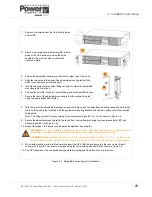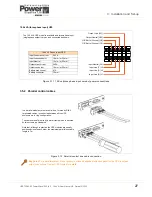
3: Installation and Set-up
30
UPS725-02-02 PowerWave 1000 (4.5 - 10 kVA) User Manual UK Dated 13/03/15
3.7
Commissioning procedure (parallel module system)
Use this procedure to commission a parallel module, redundant or capacity UPS system.
Commissioning a parallel UPS system comprises the following steps:
• Independent commissioning of each UPS module – paragraph 3.7.1.
• Configuring each UPS module for parallel operation – paragraph 3.7.3.
• Parallel system start-up and testing – paragraph 3.7.4.
3.7.1 Independent set-up of each UPS module
Use the following procedure to set-up each UPS module in turn.
1. Check that the utility supply voltage matches the input voltage range specified on the UPS data plate.
2. Connect the UPS output cables but ensure the load is isolated from the UPS output (load distribution isolator must be
open).
3. Connect the battery cable (supplied) between the UPS enclosure and battery enclosure (see Figure 2.7). Note that
the connector should be secured in place using the supplied metal bracket.
4. Connect the UPS input power cables to the utility supply (and bypass supply cables to the bypass mains supply if
using a split bypass input on the 8 kVA and 10 kVA models) as shown in paragraph 3.5.1.
5. Turn
ON
the utility/bypass supply, close the input circuit breaker and the battery circuit breaker, located on the rear of
the enclosures.
a) The LCD display will turn on and all of its symbols will illuminate for approximately 3 seconds.
b) The status leds will all turn on for approximately 3 seconds and then extinguish except for the utility input supply
and bypass supply (green) leds, which will remain lit.
c) The LCD panel will indicate that the battery is on charge and the UPS is
off
.
6. Simultaneously press and hold the
ON
and
DOWN
buttons for 3~5 seconds, until a beep is heard, and then release
them.
a) The LCD will display
b_on
. This indicates that the UPS is now in its set-up mode.
Bypass voltage window
7. Press the
DOWN
button twice.
a) The LCD indication will scroll through
tnon
and end up showing either
S_Lo
or
S_H1
. This indicates the applied
bypass voltage window.
S_Lo
sets the bypass window to 184~260 VAC and
S_H1
sets it to 195~260 Vac.
8. Press the
UP
button to select the wanted bypass voltage window (either
S_Lo
or
S_H1
is displayed).
Inverter frequency sync window
9. Press the
DOWN
button.
a) The LCD indication will now show either
St01
Hz
or
St03
Hz
. This indicates the permitted bypass frequency
window to which the UPS inverter will synchronise.
St01
Hz
sets the frequency window to ±1 Hz and
St03
Hz
sets it to ±3 Hz.
10. Press the
UP
button to select the wanted bypass frequency sync window.
CAUTION: Before you carry out this procedure you must be familiar with the Operator Control Panel functions
and the rear panel connections (see paragraph 2.4 and paragraph 2.5).
You should also be familiar with the safety information contained in Chapter 1.
Key Point:
The selected operating parameters of all the UPS modules must be identical.
Key Point:
The output voltage of all modules should be within 1V of each other when operating individually. If a
module’s voltage is greater than 1V compared with the others you should calibrate its output as described in
3.7.2 before configuring the parallel system functions.
Содержание PowerWAVE 1000
Страница 1: ...PowerWAVE 1000 4 5kVAto10kVASinglePhaseModels UserManual ...
Страница 2: ......
















































